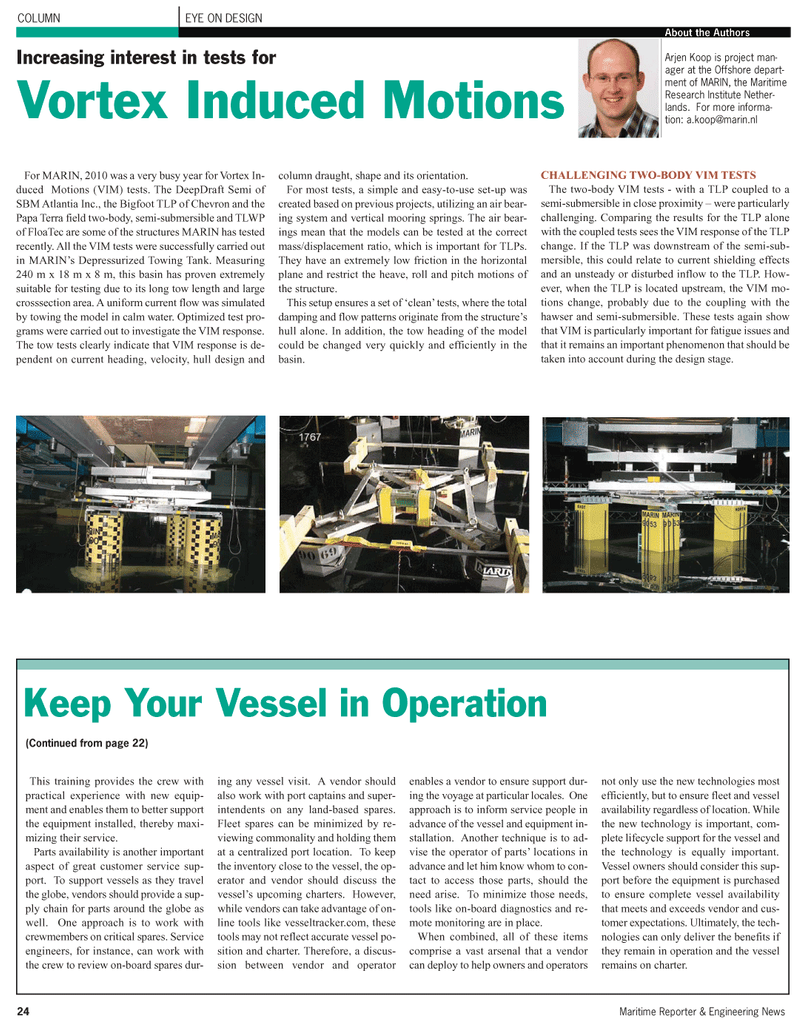
Page 24: of Maritime Reporter Magazine (June 2011)
Feature: Annual World Yearbook
Read this page in Pdf, Flash or Html5 edition of June 2011 Maritime Reporter Magazine
24Maritime Reporter & Engineering News COLUMNEYE ON DESIGNThis training provides the crew with practical experience with new equip- ment and enables them to better supportthe equipment installed, thereby maxi-mizing their service.Parts availability is another important aspect of great customer service sup-port. To support vessels as they travel the globe, vendors should provide a sup- ply chain for parts around the globe aswell. One approach is to work with crewmembers on critical spares. Service engineers, for instance, can work with the crew to review on-board spares dur- ing any vessel visit. A vendor should also work with port captains and super- intendents on any land-based spares. Fleet spares can be minimized by re-viewing commonality and holding them at a centralized port location. To keep the inventory close to the vessel, the op- erator and vendor should discuss the vessels upcoming charters. However, while vendors can take advantage of on- line tools like vesseltracker.com, these tools may not reflect accurate vessel po- sition and charter. Therefore, a discus- sion between vendor and operator enables a vendor to ensure support dur- ing the voyage at particular locales. One approach is to inform service people in advance of the vessel and equipment in- stallation. Another technique is to ad- vise the operator of parts locations in advance and let him know whom to con- tact to access those parts, should theneed arise. To minimize those needs, tools like on-board diagnostics and re- mote monitoring are in place. When combined, all of these itemscomprise a vast arsenal that a vendor can deploy to help owners and operators not only use the new technologies most efficiently, but to ensure fleet and vessel availability regardless of location. While the new technology is important, com- plete lifecycle support for the vessel and the technology is equally important.Vessel owners should consider this sup- port before the equipment is purchasedto ensure complete vessel availability that meets and exceeds vendor and cus- tomer expectations. Ultimately, the tech- nologies can only deliver the benefits if they remain in operation and the vessel remains on charter. Keep Your Vessel in Operation (Continued from page 22) For MARIN, 2010 was a very busy year for Vortex In- duced Motions (VIM) tests. The DeepDraft Semi of SBM Atlantia Inc., the Bigfoot TLP of Chevron and the Papa Terra field two-body, semi-submersible and TLWP of FloaTec are some of the structures MARIN has tested recently. All the VIM tests were successfully carried out in MARINs Depressurized Towing Tank. Measuring 240 m x 18 m x 8 m, this basin has proven extremely suitable for testing due to its long tow length and large crosssection area. A uniform current flow was simulated by towing the model in calm water. Optimized test pro- grams were carried out to investigate the VIM response. The tow tests clearly indicate that VIM response is de- pendent on current heading, velocity, hull design and column draught, shape and its orientation.For most tests, a simple and easy-to-use set-up was created based on previous projects, utilizing an air bear- ing system and vertical mooring springs. The air bear- ings mean that the models can be tested at the correctmass/displacement ratio, which is important for TLPs. They have an extremely low friction in the horizontal plane and restrict the heave, roll and pitch motions of the structure. This setup ensures a set of clean tests, where the total damping and flow patterns originate from the structures hull alone. In addition, the tow heading of the model could be changed very quickly and efficiently in the basin.CHALLENGING TWO-BODY VIM TESTS The two-body VIM tests - with a TLP coupled to a semi-submersible in close proximity ? were particularlychallenging. Comparing the results for the TLP alonewith the coupled tests sees the VIM response of the TLP change. If the TLP was downstream of the semi-sub- mersible, this could relate to current shielding effects and an unsteady or disturbed inflow to the TLP. How- ever, when the TLP is located upstream, the VIM mo- tions change, probably due to the coupling with thehawser and semi-submersible. These tests again show that VIM is particularly important for fatigue issues and that it remains an important phenomenon that should betaken into account during the design stage. Increasing interest in tests for Vortex Induced Motions About the AuthorsArjen Koop is project man- ager at the Offshore depart- ment of MARIN, the MaritimeResearch Institute Nether- lands. For more informa- tion: [email protected]

 23
23

 25
25
